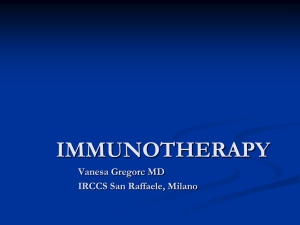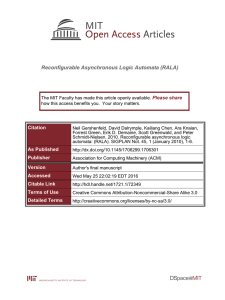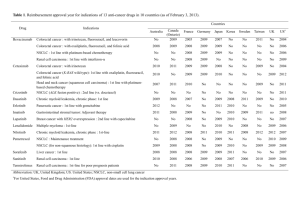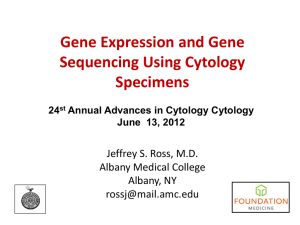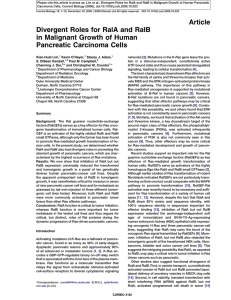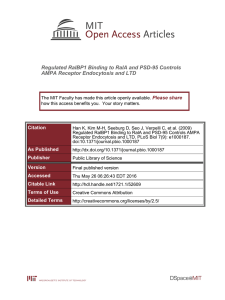JTO-D-13-00405 Revision 1 SUPPLEMENTARY INFORMATION C
advertisement
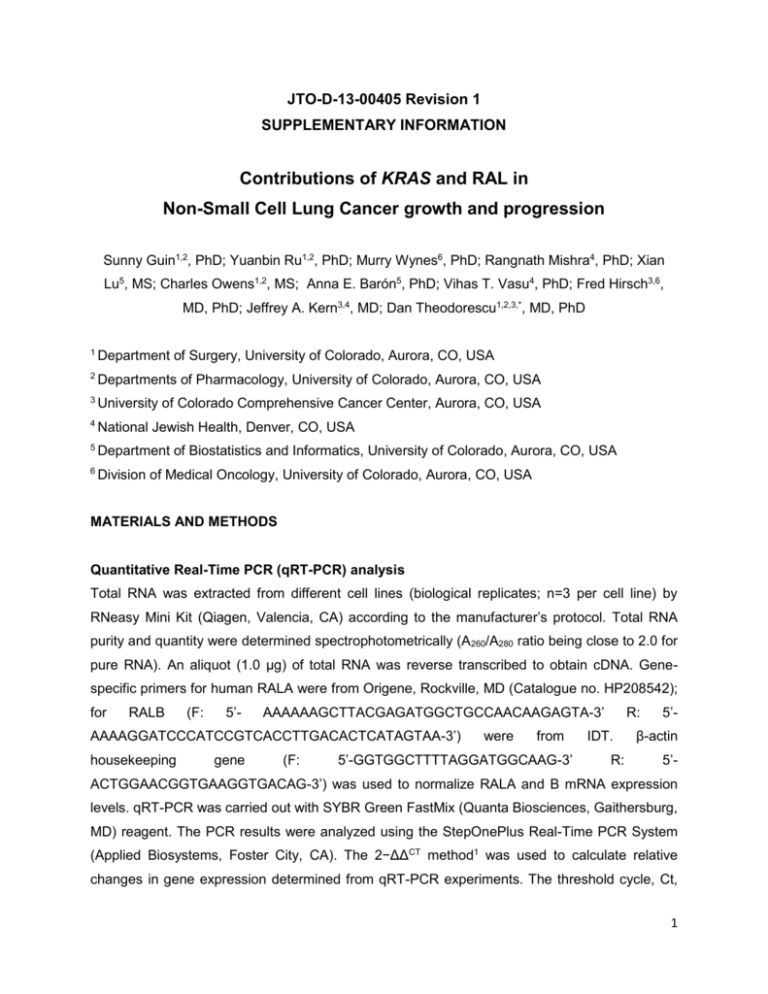
JTO-D-13-00405 Revision 1 SUPPLEMENTARY INFORMATION Contributions of KRAS and RAL in Non-Small Cell Lung Cancer growth and progression Sunny Guin1,2, PhD; Yuanbin Ru1,2, PhD; Murry Wynes6, PhD; Rangnath Mishra4, PhD; Xian Lu5, MS; Charles Owens1,2, MS; Anna E. Barόn5, PhD; Vihas T. Vasu4, PhD; Fred Hirsch3,6, MD, PhD; Jeffrey A. Kern3,4, MD; Dan Theodorescu1,2,3,*, MD, PhD 1 Department of Surgery, University of Colorado, Aurora, CO, USA 2 Departments of Pharmacology, University of Colorado, Aurora, CO, USA 3 University of Colorado Comprehensive Cancer Center, Aurora, CO, USA 4 National Jewish Health, Denver, CO, USA 5 Department of Biostatistics and Informatics, University of Colorado, Aurora, CO, USA 6 Division of Medical Oncology, University of Colorado, Aurora, CO, USA MATERIALS AND METHODS Quantitative Real-Time PCR (qRT-PCR) analysis Total RNA was extracted from different cell lines (biological replicates; n=3 per cell line) by RNeasy Mini Kit (Qiagen, Valencia, CA) according to the manufacturer’s protocol. Total RNA purity and quantity were determined spectrophotometrically (A260/A280 ratio being close to 2.0 for pure RNA). An aliquot (1.0 µg) of total RNA was reverse transcribed to obtain cDNA. Genespecific primers for human RALA were from Origene, Rockville, MD (Catalogue no. HP208542); for RALB (F: 5’- AAAAGGATCCCATCCGTCACCTTGACACTCATAGTAA-3’) housekeeping gene R: AAAAAAGCTTACGAGATGGCTGCCAACAAGAGTA-3’ (F: were from 5’-GGTGGCTTTTAGGATGGCAAG-3’ IDT. R: 5’- β-actin 5’- ACTGGAACGGTGAAGGTGACAG-3’) was used to normalize RALA and B mRNA expression levels. qRT-PCR was carried out with SYBR Green FastMix (Quanta Biosciences, Gaithersburg, MD) reagent. The PCR results were analyzed using the StepOnePlus Real-Time PCR System (Applied Biosystems, Foster City, CA). The 2−ΔΔCT method1 was used to calculate relative changes in gene expression determined from qRT-PCR experiments. The threshold cycle, Ct, 1 which correlates inversely with the target mRNA levels, was measured as the cycle number at which the SYBR Green emission increases above a preset threshold level. Immunohistochemical Analysis Patient population Primary tumor samples were obtained from 189 consecutive NSCLC patients initially staged I– III (Union for International Cancer Control, TNM classification of malignant tumours, 6 th edition) who underwent curative pulmonary resection at the Medical University of Gdansk, Poland, between 2001 and 2004. Since positron emission tomography (PET) was not available during this period, a few patients were upstaged at surgery, thus resulting in a portion of patients with pathological stage III (32%) and stage IV (4%), all of which were included in this study. Induction or adjuvant chemotherapy was used in a small fraction of patients (4% and 2%, respectively). Disease-free survival (DFS) was calculated from the date of surgery to the date of relapse (distant or local), death of any cause or last follow-up. Overall survival (OS) was defined as the time between surgery and death of any cause or last follow-up. Median follow-up was 5.3 years (range: 1.1-6.9 years). Institutional Review Boards from the Medical University of Gdansk and the University of Colorado approved this research. Tissue microarray preparation Tissue microarrays (TMA) were prepared as described 2. Three 1.5 mm diameter cores from representative tumor areas were obtained from each formalin-fixed paraffin-embedded tumor block and processed using the MaxArray service (Invitrogen, South San Francisco, CA). Sections of 4 m were cut from TMA master blocks, mounted on slides and processed as described below. RALA and RALB protein expression by IHC IHC was performed in a CLIA certified laboratory. Slides were dried at 60˚C for 1 hour and subsequently rehydrated. Antigen retrieval consisted of 20 minutes in a Decloaking Chamber (Biocare Medical, Concord, CA) at 105˚C using Dako Target Retrieval Solution (Dako, Carpinteria, CA, cat#S1699) at pH 6.1 and then cooled in an ice bath. After 3 rinses with Dako Wash Buffer the slides were placed on the Dako Autostainer. Slides were then quenched for endogenous peroxidase using 3% H2O2 for 10 minutes then pre-incubated in Universal Blocking Reagent (BioGenex, Fremont, CA, cat#HK085-5K) for 10 minutes to reduce nonspecific binding. The slides were next incubated for 1 hour at room temperature with an anti-RALA mouse 2 monoclonal antibody (BD Biosciences, San Jose, CA cat#610221) at a dilution of 1:800 or an anti-RALB mouse monoclonal antibody at a dilution of 1:400 (Abgent Inc., San Diego, CA, cat#AT3553a). After Wash Buffer rinse, the slides were incubated with HRP labeled Dual Link System (Dako EnVision+ cat#K4061) for 30 minutes. Slides were rinsed again and the chromogen was developed for 7 minutes with liquid 3, 3-Diaminobenzidine (Dako. cat#K3468). Finally, the sections were counterstained with hematoxylin (Dako. cat#S3301), dehydrated, cleared and coverslipped. RALA and RALB staining was assessed on an Olympus BX41 light microscope, without clinical information. In the evaluation of the RAL expression, the immunostained cells were graded according to cytoplasmic and membranous staining. The cytoplasmic staining intensity within the tumor tissue was graded on a scale of 0 (negative, no cytoplasmic staining), 1 (low, mild cytoplasmic staining), 2 (moderate cytoplasmic staining) and 3 (strong cytoplasmic staining). The membranous staining intensity and pattern were graded on a scale of 0 (negative, no membrane staining), 1 (faint, partial membrane staining), 2 (weak circumferential membrane staining), 3 (intense, circumferential membrane staining). The percentage of positive tumor cells were calculated for each specimen, and this percentage were multiplied by the staining intensity to obtain an H-score (range, 0-300). A “membrane plus cytoplasm” H-score was obtained by adding cytoplasmic and membranous H-scores for each core. Microarray Analysis Three NSCLC patient datasets (Supp. Table 3) were used to examine whether RALA or RALB gene expression could stratify patient overall survival or recurrence-free survival. Processed data were obtained from Gene Expression Omnibus (http://www.ncbi.nlm.nih.gov/geo). Patients in each dataset were divided into two groups by two methods and were compared by Cox proportional hazards models and log-rank tests. In the first method, patients with high (top 25%) RALA or RALB expression at the probe set level was compared with those with low (bottom 25%) expression. In the second method, a “Risk Score” was calculated for each patient using a leave-one-out approach by fitting a Cox proportional hazards model to the microarray data on all other patients that included either all RALA or all RALB probe sets. The risk score was the product of the patient’s RALA or RALB expression and coefficients given by the Cox model. Patients with high (top 25%) risk scores were then compared to those with low (bottom 25%) scores. 3 For KRAS and RAL genes in the univariate analysis, the probe set with the highest mean expression across patients was selected to represent a gene’s expression if there are multiple probe sets for the gene in a dataset. To analyze the interaction between KRAS and RAL genes, a patient is classified as either high- or low-expressing using a gene’s median expression. Patient groups with different expression levels of KRAS and RAL genes were compared by Cox proportional hazards models and log-rank tests. In univariate analyses, the following characteristics, when available, were included in Cox proportional hazards models: age, gender, histology (adenocarcinoma vs. squamous), pathological stage (low (stages I & II) vs. high (stage III & IV)), KRAS, RALA, and RALB expressions. P-values were given by Wald tests. 4 REFERENCES 1.Livak KJ, Schmittgen TD. Analysis of relative gene expression data using real-time quantitative PCR and the 2(-Delta Delta C(T)) Method. Methods 2001;25:402-408. 2.Dziadziuszko R, Merrick DT, Witta SE, et al. Insulin-like growth factor receptor 1 (IGF1R) gene copy number is associated with survival in operable non-small-cell lung cancer: a comparison between IGF1R fluorescent in situ hybridization, protein expression, and mRNA expression. J Clin Oncol 2010;28:2174-2180. 5 SUPPLEMENTARY TABLES Supplementary Table 1. Details of the NSCLC patient tumors used for immunohistochemical (IHC) analysis. Characteristics N (%) Age Median 64 Range 35-85 >60 118 (62) Gender Males 144 (76) Females 45 (24) Pathological Stage I 75 (40) II 42 (22) III 61 (32) IV 8 (4) Unknown 3 (2) Grade G1 20 (11) G2 81 (43) G3 63 (33) Unknown 25 (13) Histology Squamous Cell Carcinoma 103 (54) Adenocarcinoma 55 (29) Large Cell NSCLC NOS/MIXED* Other 5 (3) 24 (13) 2 (1) Smoking Ever Never 180 (95) 9 (5) Progression-Free Survival Years - Median 1.5 Overall Survival Years - Median 2.1 6 *NSCLC NOS/MIXED - Non Small Cell Lung Cancer whose histology is not otherwise specified (NOS)/ mixed adenocarcinoma and squamous cell carcinoma characteristics. Supplementary Table 2. Multivariate analysis for RALA and B on IHC samples for overall survival (OS). RALA Multivariate Analysis Parameter Comparison RALA IHC <25% percentile vs. score >75% percentile (Membrane) 25%-50% percentile vs. Multivariate 95% Confidence Interval of Multivariate Hazard Ratio Hazard Ratio P-value 0.769 (0.423, 1.399) 0.3894 1.079 (0.63, 1.846) 0.7821 1.201 (0.69, 2.089) 0.5179 2 vs. 1 1.52 (0.856, 2.696) 0.1527 3 vs. 1 3.757 (2.287, 6.171) <0.0001 4 vs. 1 7.27 (3.028, 17.456) <0.0001 1.022 (0.999, 1.046) 0.063 0.799 (0.496, 1.286) 0.3549 1.063 (0.559, 2.022) 0.852 0.721 (0.434, 1.197) 0.2055 >75% percentile 50%-75% percentile vs. >75% percentile Stage Age Histology Adenocarcinoma vs. Squamous NSCLC NOS/MIXED vs. Squamous Gender Female vs. Male RALB Multivariate Analysis Parameter Comparison RALB IHC <25% percentile vs. score >75% percentile (Membrane) 25%-50% percentile vs. Multivariate 95% Confidence Interval of Multivariate Hazard Ratio Hazard Ratio P-value 0.552 (0.314, 0.97) 0.0388 0.55 (0.313, 0.967) 0.0377 0.951 (0.555, 1.63) 0.8548 2 vs. 1 1.47 (0.84, 2.571) 0.1774 3 vs. 1 3.901 (2.365, 6.435) <0.0001 4 vs. 1 8.603 (3.577, 20.688) <0.0001 1.03 (1.006, 1.054) 0.0148 0.747 (0.453, 1.231) 0.2519 1.126 (0.597, 2.124) 0.7129 >75% percentile 50%-75% percentile vs. >75% percentile Stage Age Histology Adenocarcinoma vs. Squamous NSCLC NOS/MIXED vs. Squamous 7 Gender Female vs. Male 0.73 (0.434, 1.228) 0.2355 Supplementary Table 3. Detail of NSCLC transcriptomic datasets used for bioinformatic analysis Dataset GSE4716_GPL3694 GSE8894 Platform Tumors and Histology Survival * Gender * N=50 (30 adeno, 16 NSCLC: 15F, 35M GPL3694 GPL570 squamous, 4 large cell) N=138 (62 adeno, 76 squamous) OS Adeno: 15F, 15M NSCLC: 34F, 104M DFS Adeno: 29F, 33M N=149 (90 adeno, 35 GSE11969 GPL7015 squamous, 20 large cell, 4 adenosquamous) OS NSCLC: 48F, 101M Adeno: 43F, 47M *OS is overall survival; DFS is disease free survival l; M is male; F is female. Supplementary Table 4. qRT-PCR analysis for RALA and B mRNA expression in non-small cell lung cancer cell lines normalized to β-actin RALA Cell Lines SW1573* Calu-6* H2009* H358* H2122* H460* H157* A549* H292 H2228 H1703 HCC4006 Calu-3 H322 2^−(delta Ct) Average 0.014 0.013 0.012 0.013 0.012 0.020 0.014 0.006 0.007 0.014 0.009 0.015 0.014 0.006 RALB SEM 0.0031 0.0020 0.0013 0.0020 0.0007 0.0013 0.0012 0.0001 0.0006 0.0015 0.0011 0.0018 0.0045 0.0004 2^−(delta Ct) Average 0.00007 0.01162 0.00031 0.00049 0.00650 0.00010 0.00006 0.00014 0.00005 0.00036 0.00015 0.00025 0.00008 0.00868 SEM 0.00001 0.00102 0.00007 0.00001 0.00083 0.00001 0.00001 0.00001 0.00001 0.00001 0.00001 0.00003 0.00002 0.00080 *Cell lines with KRAS mutation 8 SUPPLEMENTARY FIGURE LEGENDS Supplementary Figure 1. RALA membrane (Mem) and cytoplasmic (Cyto) expression do not change as a function of NSCLC (A) stage and (B) grade as evaluated by IHC. Similarly RALB membrane (Mem) and cytoplasmic (Cyto) expression is unchanged across NSCLC (C) stage and (D) grade as evaluated by IHC. Supplementary Figure 2. Overall NSCLC patient survival as a function of (A) RALA and (B) RALB membrane expression by IHC. Overall NSCLC patient survival as a function of (C) RALA and (D) RALB membrane + cytoplasmic expression as evaluated by IHC. Supplementary Figure 3. Patient survival in NSCLC datasets GSE8894 and GSE11969 (Supp Table 3) as a function of RALA (A) mRNA expression or (B) Risk Score (see Materials and Methods). (C) Overall patient survival in NSCLC dataset GSE4716_GPL3694 as a function of RALB expression. Supplementary Figure 4. Densitometric analysis on the western blots in Figure 3 to study the correlation between (A) RALA and (B) RALB protein expression and activation on the panel of 14 NSCLC cell lines. RAL expression and activation are plotted on the X and Y axis respectively. Supplementary Figure 5. Knockdown of RALA, RALB and RALA+RALB in NSCLC cell lines. Cells were transfected with 100nM siRNA against RALA (siRALA), B (siRALB) or both (siRALA+B). 72hrs after transfection cells were lysed, and detected for RAL knockdown by western blot using specific antibodies against RALA and RALB. A luciferase siRNA transfected cells are used as control (siCTL). Supplementary Figure 6. RALA and B were knocked down in H2122 cells using a second set of siRNA (siRALA II and siRALB II) using similar protocol. (A) Cells were lysed 72 hrs after transfection and knockdown was detected by western blot. (B) H2122 cells were transfected with RAL siRNAs: siRALA II and siRALB II and plated in agar as mentioned earlier. Colonies formed were stained and counted as mentioned earlier. Reduced anchorage independent 9 growth was observed with RALA and B knockdown. *P<0.05 by student’s t-test. Data from one of two experiments is shown. Supplementary Figure 7. Western blot on the panel of NSCLC cell lines for activated and total AKT and ERK to study signal transduction through PI3K/AKT and MAPK pathways downstream of KRAS in these cell lines. Asterisks indicate cell lines with KRAS mutations. 10
